![PR Globe Trotting From Germany to Dubai [Podcast]](https://www.veracityagency.com/wp-content/uploads/Katharina-Hicker-800x600-1.jpg)
by Josh Friesen | Jun 15, 2022 | Digital PR, Podcast, Public Relations
On this week’s episode of the PR Talk Podcast, host Amy Rosenberg chats with Katharina (Kat) Hicker, founder of Castleforbes Communications and co-founder of the Speakeasy Club. Kat calls in from her home in The United Arab Emirates to talk about her career and what it’s like running PR campaigns in so many different parts of the world.
A Global Career Trajectory
Kat started her PR career as a freelancer in Germany before joining the McDonald’s in-house team in 2012 at its headquarters in Munich. In 2015, Kat moved to Ireland and began working for Google. Three years later, she moved to Amsterdam to head the company’s B2B PR efforts in Northern Europe.
Kat left Google in 2020 and moved to Dubai, where she joined Careem — the Uber of the Middle East — as its global director of communications, public relations and social media. In 2021, Kat left Careem and launched Castelforbes, which offers PR services and media training to organizations in the United States, Europe and the Middle East.
PR Practices Around the World
When asked what it was like to run campaigns in so many different countries, Kat described how each place has its own unique rules, which PR professionals need to understand before pitching.
The Middle East
As Kat describes it, the Middle East is “wild,” with a very informal pitching process involving WhatsApp messages and in-person conversations over coffee. Kat said she appreciates less process and more human interaction, but the informality in this approach leaves less for PR pros to rely on.
Continental Europe
Europe has a more formal process than the Middle East or the U.S., with much longer lead times. Many organizations in continental Europe publish quarterly, which means pitches have to be very precise.
The United Kingdom
Journalists in the United Kingdom are some of the toughest Kat has ever dealt with and approach their role from a more adversarial perspective. She says they have a practice of asking for comments on difficult stories late on Friday afternoons, so PRs and their clients have less time to form quality responses.
The United States
The U.S. falls between the Middle East and Europe in formality, but journalists here are much more likely to offer feedback and opportunities for improvement when they say no.
As for what these regions have in common, Kat says how you write a press release is the same just about everywhere. Timing is also the same, with most pitches going out between 10 am – 2 pm on Wednesdays and Thursdays. Perhaps most importantly, journalists everywhere appreciate it when you send a quality piece of writing.
Advice for Yourself First Starting out
Amy ended the conversation by asking Kat what advice she’d have for herself when she was just starting out in the industry. Kat said it would be to embrace the mistakes that you’re making because they’re the best way to learn. Rather than seeing mistakes as a failure, see them as a lesson and use them to do better, which is advice we all could benefit from.
Don’t Miss an Episode
Amy and Kat covered much more during their conversation, including Kat’s approach to using freelancers and her process for handling crisis communications, so make sure to listen to the entire episode. After you’ve finished, don’t forget to subscribe to the PR Talk podcast on iTunes, Stitcher, Google Podcasts, iHeart Radio and Spotify.
About the guest: Katharina Hicker
Katharina Hicker is a PR and communications professional with more than 12 years of experience in Fortune 500 companies. She’s also the co-founder of “The Speakeasy Club” and founder and managing director of Castleforbes Communications. Her work focuses on supporting tech businesses of all sizes with their communications strategies and PR campaigns, as well as teaching current and future executives to become the best and most confident speakers possible.
Connect and follow Kat on social media:
PR Talk is part of the Marketing Podcast Network
The Marketing Podcast Network gives brands that sell to marketers direct access to reach thousands of buyers via their trusted media source: Marketing podcasts. Browse our library of shows and see where your message can be placed to reach prospective customers ripe for your message.
This episode of PR Talk is brought to you by PRSA Oregon
Throughout Oregon and Southwest Washington, PRSA provides members with networking, mentorship, skill building and professional development opportunities – whether you are a new professional fresh out of college or a skilled expert with 20 years in the industry. Check out PRSAoregon.org for more information on how membership can help you grow and connect.
![Staying Ahead of the Puck that is Google with Michael Cottam [Podcast]](https://www.veracityagency.com/wp-content/uploads/Michael-Cottam-800x600-1.jpg)
by Amy Rosenberg | Feb 24, 2021 | Podcast, Public Relations, SEO
Staying Ahead of the Puck that is Google with Michael Cottam
“I skate to where the puck is going, not where it has been.” — Wayne Gretzky.
Somewhere in the middle of the PR Talk conversation I had with Michael Cottam he cited this quote in reference to how he approaches search marketing. This means that Michael doesn’t just focus on what Google is doing, he broadens his view to what Google will be doing. There couldn’t be a more fascinating way to think about the ever-evolving topic of search, and especially how it relates to PR.
Michael Cottam is a renowned search engine optimization (SEO) expert who many in the search industry already know. Beyond providing highly-coveted search consultation for clients, Michael is the founder of Visual Itineraries, which he calls his SEO “sandbox” because it is where he tests search theories for clients.
Always full of great information, I am normally talking with Michael either at a busy conference or while collaborating on a mutual client. So I took this dedicated time to really dig in and get my questions answered. Even if my questions are in the weeds or are very technical, I don’t care because it will help us help Veracity’s SEO PR clients!
Battle of the SEOs: Does Michael Agree with Rand About Links?
First, I had to know if Michael agreed or disagreed with Rand Fiskin’s notion that links are not nearly as important as they once were for SEO (check out the last PR Talk interview with Rand titled “The Wall Street Journal Problem” for more context).
Michael wholeheartedly agreed with Rand.
The backstory is that Google used to rank web pages higher in search engines by relying on quantifying their external links. But now, Google has improved its ability to recognize quality content within web pages. While links are still important, websites that thoroughly cover specific topics will in turn rank for those specific topics.
Google’s E-A-T Attempts to Take the Consumer’s Place
Michael explains that in addition to links, Google is now considering “E-A-T,” which stands for “Expertise, Authority and Trust,” to rank web pages. For example, Google can determine the authority of a web page by attempting to discover who wrote the page and then follow a trail back to previous content by that author. If the author has written authoritative posts and been included (mentioned) as a source in other websites, Google will consider them an expert, thus trusting the page. Therefore, thought leader names are becoming just as important, or possibly even more important, than company names — in terms of establishing credibility and resulting SEO.
Since Veracity handles a lot of guest article placement for thought leaders, I wanted to dig into this concept further. I would think that name credibility could be built by landing many guest article placements. However, Michael said that interviews (or getting names included in articles) by credible third-party sources (such as reporters) are just as important. You want a mix of both to build your thought leader’s name, as well as the company name.
The E-A-T concept allows Google to mechanically re-create what consumers would see along the decision-making process and ultimately what websites they would click on. In this way, Google essentially acts like a consumer to serve its customers (web searchers).
Schema Markup Can Help Us Tier Press Lists
Back to my favorite topics of links, if all else is equal, of course you’d place more intrinsic value on the website article that also provides a followed link to your website. However, we could also review the “schema markup” (a type of structured data) of web pages. This hidden code enables search engines to understand what the page actually is about — so it can more readily appear in searches. For example, appropriate schema markup will tell Google that a webpage is really a press article, as well as who published and wrote it.
PR people should not inquire or advise press/web contacts about schema markup. This is a much bigger deal than simply asking the press to add a link into a previously written article. Additionally, there are ways we can discover who is using ideal schema markup in order to tier websites/press by using Google’s Structured Data Testing Tool or Rich Results Test to see if the site is using structured data (see more about these tools in this Search Engine Land article).
Are No-Follow Links the Devil?
For a long time we have been talking about no-follow links not being very great for SEO. However, Mike Rosenberg has been unsure about this for a while, so we posed the question to Michael Cottam.
He said that Google cares very much about “user-generated links” (links generated by others), which are found on social media sites, such as LinkedIn and Twitter, and on forums and places like Reddit and Quora. You want a mix of outside press (links and/or mentions from other websites) and buzz from user-generated links, which are no-follow, because they show what is hot right now.
However, there should be a natural bell curve pattern in the links. You don’t want to do a bunch of Facebook ads to generate comments and links for users at only one time. Ideally, you’d get some outside press coverage first and then share that article on social media (with some budget behind it) to show Google that people are also talking about you, which will increase the search impact of the original article.
We talked about so much more in the interview. More detailed questions — such as how to approach keywords when writing press materials — were answered. And larger topics, such as: 1) how search and PR teams can effectively work together, and 2) if search and PR could ever be combined into one role. That was an easy no!
Don’t Miss an Episode
You can access more great episodes by subscribing to the PR Talk podcast on iTunes, Stitcher, Google Podcasts, iHeart Radio and Spotify.
About the guest: Michael Cottam
Michael Cottam is the founder of Visual Itineraries, a sales closing and lead-generation tool for travel agents, and is an independent SEO consultant, focusing on technical organic search engine optimization, Panda optimization, and Google penalty recovery. The former SEMpdx board member is currently involved in the Rotary Club of Greater Bend, where he recently moved to be closer to the outdoors.
Connect and follow Michael on social media:
This episode of PR Talk is brought to you by PRSA Oregon
Throughout Oregon and Southwest Washington, PRSA provides members with networking, mentorship, skill building and professional development opportunities – whether you are a new professional fresh out of college or a skilled expert with 20 years in the industry. Check out PRSAoregon.org for more information on how membership can help you grow and connect.

by Talia Smith | Sep 19, 2016 | Digital Marketing, General, Posts, Public Relations, Resources, Social Media
One day during the last month of my internship at Veracity, I found myself alone in our quaint, sunny office in Portland’s Bakery Building with a brief pocket of time to myself. I admired my desk and the large computer monitor displaying a press release I wrote. I scanned our generous downtown view. I noticed my notepad that was clean with fresh yellow pages on my first day at the office was now disheveled and running out of pages after six months. Just like my notepad, I arrived on my first day as a clean blank page and left brimming with new skills, connections and a love for public relations.
How did this happen? I’m only 21-years-old with an associate degree. I was told that I would be lucky to work at a gluten free bakery when I moved from New Jersey to Portland, and yet I attained a dream internship at Veracity. I wrote press releases and blog-posts, communicated and pitched ideas to media outlets, spoke with clients and attended meetings. This is real work that many people my age will not touch for years.
How did I get here? It started when my hours were slashed at my previous retail job. I had an entire unpaid week off that helped me realize that I would rather be paid nothing if it meant gaining experience in writing and public relations. Life is too short to be sidetracked from doing exactly what you want to do. Thanks to Veracity, I was able to both gain invaluable experience in PR while collecting a stipend that will help pay for my tuition at the University of Oregon this fall.
For those looking for a dream PR internship, here are five tips to help the process go as smoothly as possible:
1. Think of an internship as an investment in your future
When I first arrived in Portland, my initial goal was to find a job where I could work as many hours as possible and make the highest wage I qualified for. I was preparing for a gap year between community college and a four-year university. What I didn’t understand at first is the jobs I applied for would not help me propel my prospective career in PR. Yes, I’d save up money and keep busy, but I wouldn’t have the real world PR skills that I do after interning at Veracity.
I urge anyone in a similar position to opt for an internship in your desired field over a well-paying job when you are first starting out. Many times they are one in the same. Just as a college degree is an investment in your future, the right internship will broaden your palette of skills, introduce you to a network of professionals in your field and act as a stepping stone to the career you are seeking post-college.
2. You can apply to companies that aren’t necessarily hiring
My internship search reached peak frustration when I applied to companies via job posting websites. Due to the fact that almost every unemployed, college-educated person in the Portland-metro area floods to websites such as Mac’s List, PDX Pipeline and Indeed, I did not hear back from any of the internships I applied for using these outlets. The moment I picked up the phone, my luck began to change.
First, I searched for all the PR firms within my immediate area and composed a list. Next, I cold-called each office and inquired whether they would be interested in hosting an intern. I received some no’s, but mostly yes’s—or at least someone willing to take a look at my resume. Many PR companies don’t necessarily have an established internship program, but from my experience, most were open to the possibility of hiring an intern. These cold-calling phone calls usually ended in a “please send your resume to this email.”
When sending the resume and cover letter via email, be sure to mention who you spoke to on the phone. I couldn’t believe how well this worked for me. I went from absolutely zero responses to having three scheduled interviews in the same week.
3. Customization is key
When I was hired, Amy told me she was not looking for an intern but reconsidered after reviewing my cover letter. I think it’s because I was really enamored by Veracity when I viewed the website. I knew that this would be the perfect place for me to work so I made sure to read over Amy and Mike’s biographies, client testimonies, blog posts and more. I put a lot of time and effort into making sure the cover letter was interesting—not generic—and also included specifics about myself and how I could be of use to Veracity.
Take the time to research a company you want to intern for and convey that knowledge in the first paragraph of your cover letter. Go on to write an interesting and eloquent inquiry explaining that although you have a lot to learn, you also have a lot to offer and list specific skills. Cover letters provide an excellent opportunity to prove your writing chops. Write in a way that proves your cover letter was written solely for the company you are applying for.
4. Go on any and all interviews
Interviewing, even for a job you don’t want, is a surefire way to build confidence for the time you find yourself interviewing for the job you actually want. During my first interview for this internship search, I knew within the first five minutes that I did not want the job a different firm was offering. It didn’t matter because conversation was flowing to the point where the interview went on for an hour. When I showed the potential employer my portfolio of writing samples, she proceeded to point out all of the mistakes she saw at a glance.
I was embarrassed at first, but then I went home, corrected the mistakes and reread my writing samples to make sure they were flawless for the next interview. I noted what worked and what didn’t and honed my pitch even more. When I was interviewing with Amy, she flipped through my portfolio and said, “See, this is exactly what I am looking for.” I was overjoyed and grateful that I had an opportunity to correct my mistakes for an interview that mattered most. There is always something positive and helpful you can take away from even the worst interviews.
5. Be a yes wo(man)
Once you land your dream internship, what you do with it is up to you, but seizing every opportunity as a learning experience is so important.
Amy and Mike gave me the option to attend certain meetings and events outside of my normal work hours and I never regretted saying “yes.” I had the opportunity to attend live tapings of our client on the local news, sit in and contribute to meetings, not to mention, attend Engage (formerly called SearchFest), Portland’s premier digital marketing conference, at no cost.
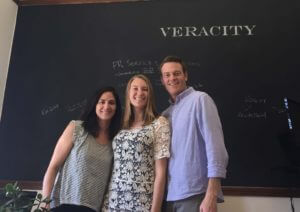 As I am preparing for my first term back at college as a PR major at the University of Oregon, I am constantly reminded how lucky I am to have spent 2016 at Veracity. Some college students have this fear of graduating and not finding a job in their field and I am happy to report that I do not have this fear at all. I will be just as tenacious about finding my post-bachelor job as I was finding my internship. I am really looking forward to going back to school but I am most looking forward to graduating and finding a job that brings me as much joy as my internship at Veracity.
As I am preparing for my first term back at college as a PR major at the University of Oregon, I am constantly reminded how lucky I am to have spent 2016 at Veracity. Some college students have this fear of graduating and not finding a job in their field and I am happy to report that I do not have this fear at all. I will be just as tenacious about finding my post-bachelor job as I was finding my internship. I am really looking forward to going back to school but I am most looking forward to graduating and finding a job that brings me as much joy as my internship at Veracity.

by Amy Rosenberg | Jan 12, 2016 | Agency Life, Client Work, Digital Marketing, Posts, Public Relations, Social Media
We get many ghost written articles placed for our clients, but like with most hard earned media, there is a story behind the recent article we placed in the Portland Business Journal (PBJ). The idea for this commentary was sparked by listening to the worries of our client. Time and time again they expressed their great concern about the lack of qualified employment candidates — rattling off many alarming facts — for these well-paying jobs.
I started on this quest to get the word out by involving the client’s national HR executive, who sent many stats that would be compelling on a national level. I used those stats in an original pitch that also conveyed an urgency of need to the PBJ. I mentioned that I’d have Oregon stats to them, if they were interested. I knew that without Oregon stats I’d have a hard time getting them to run an article but I didn’t want to invest more time in gathering the local figures without buy-in from the editor.
The publication responded to my pitch with strong interest. But they had a very short deadline of four days. It was a Friday and the article would be due the following Tuesday. On top of that, the article was only in the conceptualization phase, not a word had been written, nor had the local research been started. I am not a stranger to working on the weekend, but to make matters worse we were set to go out of town that weekend. But still, without even a draft in hand I knew we had to jump on this. What if another opportunity such as this didn’t open up with the PBJ for this particular client? You only get this level of service with a nibble firm that doesn’t have protocol to jump through.
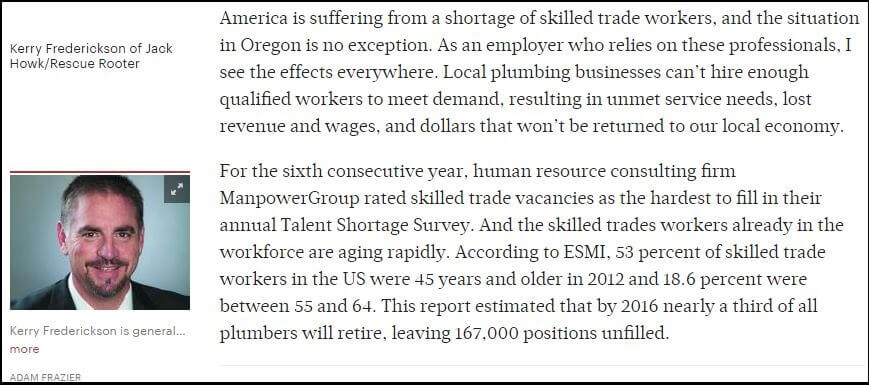
An outline, along with detailed instructions from me and some specific ideas from the PBJ editor, was provided to our writer Josh who created the first draft over the weekend while we were out of town. As usual, Josh’s article was wonderful but I realized I hadn’t provided him with enough Oregon stats. We always pay close attention to what we promise the press and aim to meet their requests.
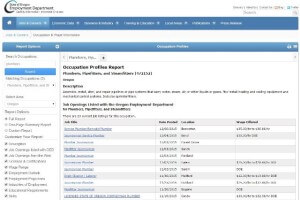
OED was very helpful providing statistics to support the article.
Business writers here are lucky that the Oregon Employment Department (OED) offers some amazing economic reports online that detail job outlook and employment stats based on industry. The hard part here was that the skilled trades are not broken out into their own specific category. The stats are lumped into the construction field, which could also consist of non-skilled trade workers such as managers and administrators. Numerous emails and phone calls with the OED helped me understand how I could break out the numbers in a way that made sense for the article. Mind you, by the time I had gotten back from the beach on Monday, I had only one day to turn this around to make deadline. I not only needed to get the Oregon stats in there, but also get it approved through various client layers (including legal!). The OED was very fast in their response to all of my questions and was a wonderful partner in this process.
Getting good articles placed goes way beyond relationships with press. It’s about paying close attention to what’s affecting your clients and translating that in a meaningful way to press. Once you have the attention of the press, you must work to understand their needs and be sure to deliver! It may not always be easy and you may have to hustle, but when articles like these hit, it’s all worth it.
![PR Globe Trotting From Germany to Dubai [Podcast]](https://www.veracityagency.com/wp-content/uploads/Katharina-Hicker-800x600-1.jpg)

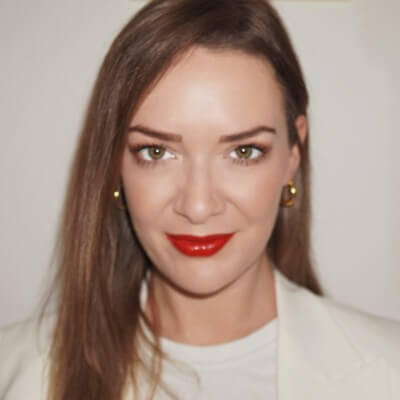
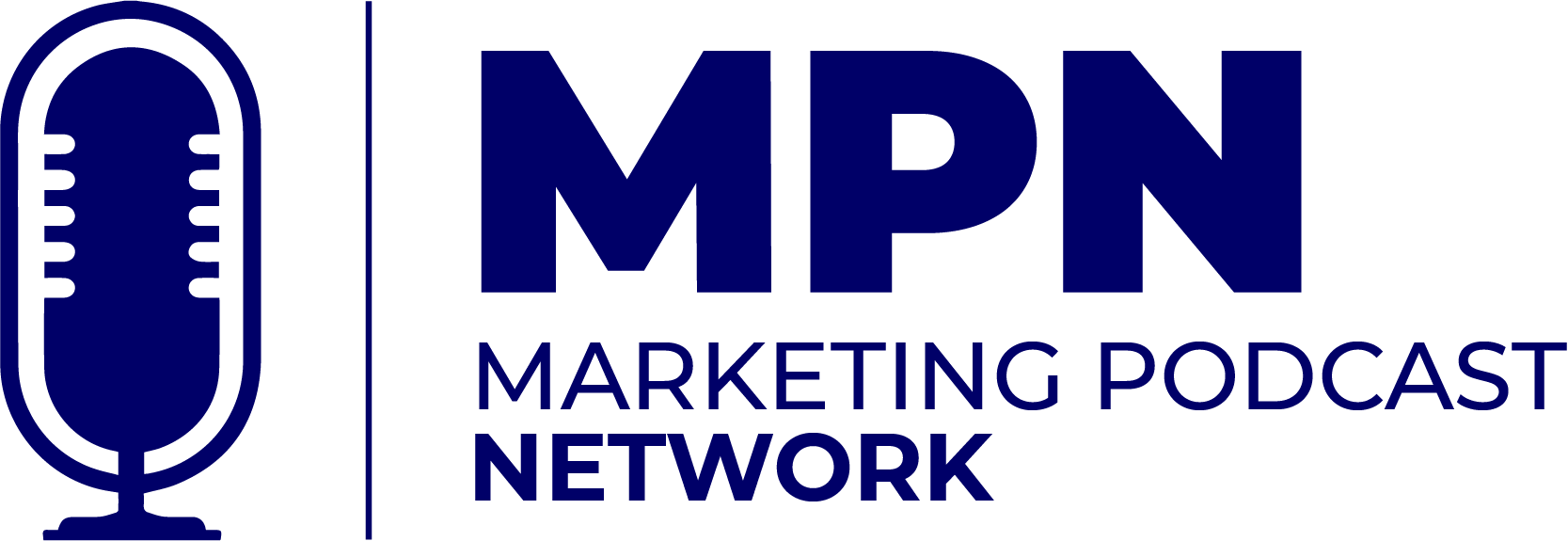
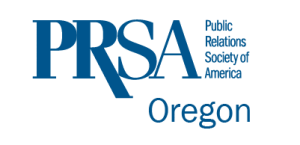
![Staying Ahead of the Puck that is Google with Michael Cottam [Podcast]](https://www.veracityagency.com/wp-content/uploads/Michael-Cottam-800x600-1.jpg)
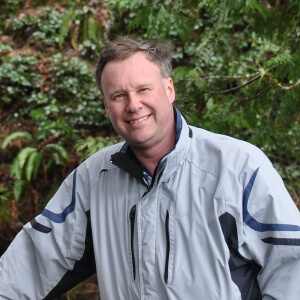
 As I am preparing for my first term back at college as a
As I am preparing for my first term back at college as a





